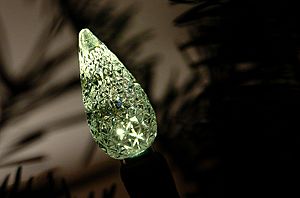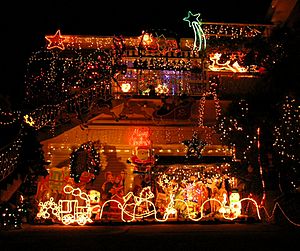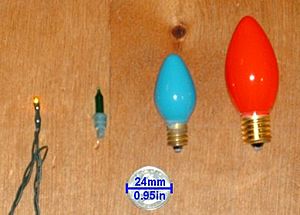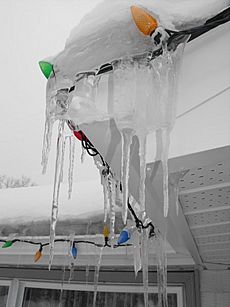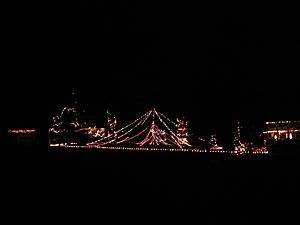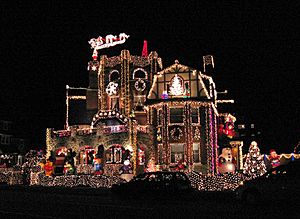Holiday lighting technology facts for kids
Holiday lighting technology has changed a lot since people first started using electric lights instead of candles. While these lights were first popular for Christmas, now you can see them all over the world for many different celebrations and even just for fun!
Contents
Types of Holiday Lights
Incandescent Lights
For a long time, holiday lights used incandescent bulbs. These bulbs make a bright white light. To get different colors, the glass part of the bulb is painted with a see-through color. This paint acts like a color filter. Some older lights from Japan even used colored glass.
Glow Discharge Lights
Another type of holiday light uses glow discharge bulbs. The most common ones are neon, argon, and mercury lamps. They glow in different colors depending on the gas inside or the special coating called a phosphor. Neon lamps glow orange, while argon lamps glow purple. Mercury lamps mostly make UV light, which we can't see. So, they have a phosphor coating inside that changes the UV light into colors like blue, green, or yellow.
LED Lights
Light-emitting diode (LED) holiday lights are super popular now! They use very little energy, last a long time, and don't need much care. Colored LEDs are much better at making light than old-fashioned colored incandescent bulbs.
There are two main kinds of LEDs: colored LEDs and white LEDs.
- Colored LEDs make a specific color of light, like red or blue. The clear plastic lens around the LED chip might be colored, but it doesn't really change the light's color. This means these lights won't fade over time because the color comes from the LED chip itself.
- White LEDs work a bit differently. First, the LED makes one color of light, usually blue or violet-blue. Then, a special phosphor coating absorbs some of this light and glows yellow. Our eyes see this mix of blue and yellow as "white." This is similar to how fluorescent lamps work.
White LEDs can be used as white holiday lights. You can also add colored covers or lenses to them to make other colors, just like with incandescent bulbs. However, these colored plastics can fade if they are left in the sunlight or get too hot. The clear plastic around the LED can also turn yellow if it's in the sun a lot.
LEDs use much less electricity (a string of 70 lights might only use 4 watts!). They also last a lot longer than incandescent lamps. Since LEDs are made of solid materials and don't have thin metal wires that can burn out or break, they are much tougher and don't break easily if you drop them.
Even though LEDs last a long time, some older or cheaper LED light strings can stop working early. This can happen especially with blue LEDs, which used to be newer and more expensive. Many LED holiday lights use copper wires that connect to the LED's metal parts. When different metals touch, they can cause something called galvanic corrosion inside the light sockets. This can make the lights stop working. Some older LED sets had each LED sealed in a waterproof base to stop this corrosion, but then you couldn't replace a broken light.
Many small LED light sets use tiny, dome-shaped LEDs. They often have a plastic cover over them to spread the light around, since LEDs usually shine in only one direction. These covers come in different shapes like pointed "strawberries" or round "raspberries." Other sets use larger LEDs with a special shape on top to spread the light without a cover. You can also find LED bulbs that screw into regular C7 and C9 sockets, looking much like the old-fashioned bulbs but using less power.
Modern LEDs can even use RGB technology, which means they can show millions of different colors! Some even have RGBW technology, adding different shades of white. This allows for amazing light shows where colors can smoothly change and fade.
One funny problem with outdoor LED lights in North America is that squirrels sometimes chew on them! Squirrels need to gnaw on hard things to keep their teeth short. They seem to like the tough plastic of LEDs. Since LEDs use very little power, the squirrels usually don't get shocked. Experts suggest leaving hard nuts on the ground to give the squirrels something else to chew on.
Fiber Optic Lights
Fiber optic technology is also used in holiday lighting, especially in fake Christmas trees. The light bulbs (incandescent or LED) are hidden in the tree's base. Thin fiber optic strands then carry the light from these bulbs all the way to the tips of the tree branches, making them glow.
Bubble Lights
Bubble lights were very popular in the 1950s. These unique lights have a sealed glass tube with a colored liquid inside. The heat from a small incandescent bulb makes the liquid bubble! The liquid was first oil, but now it's a special chemical that bubbles better. The idea for bubbling lights was first shown by Benjamin Franklin, but Carl Otis adapted it for Christmas lights in 1935. You can still buy bubble lights today!
Laser Projectors
Laser projectors became very popular around 2015. These devices are usually stuck into the ground in front of a house and project colorful dots that look like stars onto the house. They are advertised as being safer and easier to set up than traditional string lights. A company called Telebrands made them famous with their "Star Shower Laser Light." These projectors were so popular that stores quickly ran out, and some people even had them stolen from their yards!
While many people love how easy laser projectors are, some professional lighting designers aren't big fans. One called them the "lazy way" to decorate, and another said nothing beats a house fully covered in traditional lights. Also, these projectors can accidentally shine dots onto your neighbor's house or car. Star Shower even warned people not to use them within 10 miles of an airport because the lasers could bother pilots' vision.
Light Sculptures
Sometimes, lights are put onto frames, usually metal for big ones and plastic for smaller ones. These were first used for public displays on lampposts and telephone poles in cities and towns. For public displays, large C7 bulbs are often used. By the 1990s, smaller light sculptures were made for homes using miniature lights. Today, many consumer light sculptures have a plastic sheet with a printed design, sometimes even with a holographic "laser" background. Public displays often add outdoor garland to the frames, making them look great even during the day. You can see famous light sculptures in places like Gatlinburg and Pigeon Forge, Tennessee.
On a smaller scale, a very popular light sculpture is the sparkleball. Sparkleballs are handmade globes made by putting holiday lights into a sphere built from plastic cups. The cups are joined together with soldering, cable ties, or a stapler. You often see them on front porches at Christmas. In Fullerton, California, people have a tradition of hanging 450 sparkleballs from the trees on North Yale Avenue!
Light Bulb Sizes
Note: These sizes are mostly for North America and might be different in other countries.
Christmas lighting started with small C6 bulbs. The "C" means "cone" because they looked like a candle flame, and "6" means they were ¾ inches (19 mm) wide. These had a small screw-in base. Today, you can find modern versions of these bulbs.
Later, C7½ bulbs became popular. These are about 15⁄16 inches (24 mm) wide and have a blunt shape. There are also round G30 bulbs that are 30 mm wide. These bulbs are still used for a classic or retro style look and use about five watts of power each. Older ones used 7½ watts. Bubble lights and twinkle bulbs also come in this size.
For outdoor use, there are C9¼ bulbs, which are about 1+5⁄32 inches (29 mm) wide. They look similar to C7½ bulbs but use a slightly larger screw base. These bulbs use about seven watts each. You can also find round G40 bulbs that are 40 mm wide.
Standard mini lights are called T1¾. They are tube-shaped and about 7⁄32 inches (5.5 mm) wide. Most modern mini light bulbs have a special safety feature inside called a shunt. If one bulb's tiny wire (filament) burns out, the shunt closes the circuit, allowing the rest of the lights on the string to stay lit. However, if the shunt doesn't work right, the whole string might go dark.
Other small lights include round "pearl" lights and tiny "button" lights. "Rice" lights are super tiny, like a grain of rice. They are often clear and are great for decorating small models or wreaths.
LED lights are made of solid plastic, so they can be molded into many shapes. Since LEDs shine light in one direction, many LED lights have a special crystal pattern to help spread the light around. Some cheaper LED bulbs focus the light very sharply forward, which is great if you're looking at them straight on, but they might not be very bright from the side.
Most mini bulbs, including some LED sets, have a wedge base. It can be tricky to replace these bulbs because their designs aren't always the same. Often, replacement bulbs don't even come with the plastic base, so you have to reuse the old one. Because of this, many people in America just throw away mini holiday lights when they stop working. Also, colored lights can fade quickly if they are left outside in the weather. Many LED sets are now wired permanently, so you can't replace the bulbs at all.
Light Sets
Older C6 bulbs were usually 15 volts each. They were often connected in a series of eight bulbs. This meant each bulb got the right voltage to shine brightly (120 volts divided by 8 bulbs equals 15 volts per bulb). Later, some sets used nine bulbs to make the bulbs last longer by giving each one a little less voltage (120 volts divided by 9 bulbs equals 13 volts per bulb), but the lights were still bright enough.
Larger C7½ and C9¼ bulbs usually come in sets of 25. The sockets are typically spaced about one foot (30 cm) apart. These bulbs are designed to run on 120 volts AC and are wired in parallel. This means if one bulb goes out, the others usually stay lit.
Miniature lights first came in sets of 35 or 20. For a short time, these early mini lights had small screw bases and were called "Italian lights." Sets of ten bulbs were made for very small trees, but they got quite hot.
Today, incandescent mini lights usually come in sets of 50 or 100. The 100-light sets actually have two separate circuits of 50 lights. Some "extra-bright" sets use 70 or 105 bulbs.
LED sets can vary a lot. A common size is a set of 60 LEDs. White LED sets often have two circuits of 30 LEDs. Multicolor LED sets might have special wiring because red and yellow LEDs need less voltage than blue, green, or white ones.
Battery-powered sets usually have 10 or 12 lights. LEDs are becoming very common in these sets because they make the batteries last much longer. Since LEDs last so long, they are often soldered directly to the wires. "Rice lights" are also often made this way.
Controlling the Lights
Holiday lights can be made to flash or animate using special "flasher" bulbs or electronic controllers. Flasher bulbs have a tiny metal strip inside that heats up and breaks the circuit, making the light blink.
Electronic holiday light controllers usually have a small computer chip inside. This chip has a program that controls different circuits of lights, often by color. You can usually change how the lights flash or animate by pressing a button or turning a dial on the controller. Some controllers only have one pattern, but you can adjust its speed.
Many multi-function light sets have 8 to 16 different light patterns, like fading or chasing effects. These lights often come in sets of 140 or 150. This is because they need multiple circuits (like four circuits of 35 lights) to create the chasing effect. These sets use even less power than regular sets because the lights aren't always on, so they don't get as hot.
Usually, computerized light sets can't be connected end-to-end. However, some newer sets have special plugs that let you connect them. You can unplug the control box from one set and plug it into the end of another identical set to make a longer string of animated lights.
Today, computer-controlled holiday displays are becoming very common. For example, some displays use special dimmer controls that can turn lights on, off, or dim them very precisely. People use software like Light-O-Rama or xLights to create amazing light shows. With "pixels" (individually controlled LEDs), designers can change the color and brightness of each single bulb on a house! Many displays also use an FM transmitter (personal device) to send synchronized music directly to cars, so families can listen to the music that goes with the light show.
Many animated displays now use RGB lighting to create millions of colors.
A new control technology is being developed in Ottawa, Canada, that lets multiple homes link up over the Internet in real-time. A central website keeps all the local computers synchronized, and each home has a small program that controls their holiday lights. This way, anyone online can "plug in" and control their holiday lights, either independently or synchronized with others around the world!
In modern times, you can even control Christmas lights wirelessly using Wifi or Bluetooth technology. With a smartphone app, you can change the color of the lights, create different effects, or even program animations to music. Wifi-connected lights can be controlled from anywhere and can even be linked to a smart home system to turn on and off at certain times or interact with other smart devices.
Power and Safety
Most incandescent mini lights and LED sets are connected in series so they can be powered directly from your home's electricity without a large transformer. Screw-base C7 and C9 light sets use 120-volt bulbs and are wired in parallel. LED sets use a special current-limiting resistor to control the power to each LED. Battery-powered sets are also wired in parallel.
Some incandescent or LED strings use a power supply (like a small box you plug into the wall) with the lamps connected in parallel. These sets are much safer, but the lights at the end of the string might be a little dimmer because of a slight voltage drop.
Many light strings have a male plug on one end and a female socket on the other, so you can connect them end-to-end. The type of wire, the fuse rating, and how much power each string uses will determine how many strings you can safely connect together. If you connect too many, the lights at the end might be dim, or it could be unsafe.
Most light sets come with built-in fuses. These fuses help protect against overheating and stop your house's circuit breakers from tripping. If a fuse blows, you need to unplug the string and reduce the number of strings connected. If a string keeps blowing fuses, it might have a short circuit and should be fixed or thrown away.
The TV show MythBusters once did an episode about the fire danger from holiday lights, showing how important it is to use them safely.


